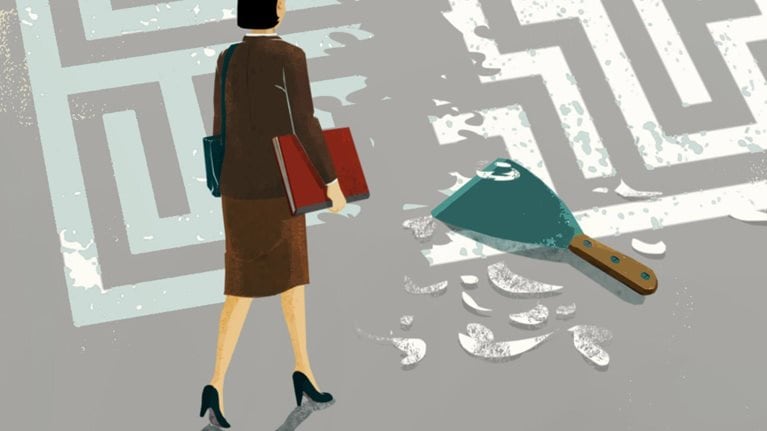During the summer of 2013—about two and a half years after the start of a major effort to increase the number and proportion of senior-leadership roles held by women at eBay Inc.1 —we conducted a global gender-diversity survey on the attitudes and experiences of our top 1,700 leaders.2 The survey revealed some good news: for example, our leaders—women and men alike—consider gender diversity an important business goal. Moreover, we found no aspiration gap: women and men, in roughly the same proportion, want to move up.
Many of the findings, however, were troubling, for they suggested that men and women experience the company in strikingly different ways. A majority of women, for instance, felt that their male colleagues didn’t understand them very well, though a majority of men felt well understood by the women. Likewise, women were significantly less likely than men to believe that their opinions were listened to and more likely to doubt that the most deserving people received promotions. Finally, we did not see any significant differences in the survey results across geographic regions. Our gender-diversity challenges (and therefore opportunities) were global ones. We were both frustrated and motivated by these survey results.3
But they didn’t necessarily surprise us. The company’s gender initiative really had significantly increased the representation of women in leadership roles. Between 2011 and 2013, in fact, their number rose by 30 percent annually, and we increased the proportion of leadership roles held by women every year. This early progress exceeded our expectations and showed that it is possible to make a difference.
Nonetheless, we believed that our demographic results ran ahead of the cultural reality—the numbers were moving in a positive direction, but the experience of women at our company wasn’t yet notably different. At the root of the challenge, we believed, was the pervasive mix of unconscious mind-sets, behavior, and “blind spots” that color anyone’s perceptions of gender. Now, with some wind at our backs from the progress on demographics, and armed with the data from the gender survey, we committed ourselves to addressing our cultural challenges.
‘This is personal’
Even getting to this point took significant effort. Gender diversity has long been a passion of our CEO, John Donahoe, but it wasn’t something he could tackle immediately upon assuming the role, in 2008. The global recession and a business turnaround at eBay came first.
By 2010, the turnaround was succeeding, and John was keen to sustain it. In a competitive marketplace for talent, he argued, eBay should create a business climate where talented women could thrive. At the end of that year, he launched our Women’s Initiative Network (WIN). Although today this effort includes women at all levels, we began with leaders, defined as directors and higher, because we wanted to start with something manageable that we could do well. Besides, if you don’t have role models at the top, it’s harder to encourage women at earlier stages of their careers to pursue their aspirations.
At our first global WIN Summit, in January 2011, eBay’s 200 highest-ranking women met with our senior-executive team for three days of professional development and networking. At the outset, John went onstage and described, in quite personal and moving terms, why gender diversity matters so much to him. He recalled one of his wife’s more challenging career experiences and concluded, “I just remember thinking: my God, she has a tougher row to hoe than me.” He went on to discuss her career experience over 25 years, the issues she has faced as a successful professional woman, and how it felt to observe all this. John finished by explaining his aspirations for WIN and his desire for a more supportive, inclusive environment at eBay. “This is personal,” he told us.
Indeed, from the outset, John’s personal conviction rather than a conventional business case inspired our gender-diversity initiative—not because the case is irrelevant4 but because it can’t, in itself, generate enough passion and conviction to sustain gender diversity as a priority. Our company’s experience thus far suggests that a committed chief executive and C-suite are essential to telegraph the importance of the effort. When senior leaders engage with something, others are encouraged to make individual commitments, establish shared goals, and accept collective accountability. Real change can’t happen without a commitment from the top, because that’s where people take their cues.
Soon after the WIN Summit, John publicly demonstrated his commitment by proposing to eBay’s board that he be held accountable for the effort’s success. The focus areas he chose included increasing the number of women in leadership roles, reducing their attrition rate below that of men, and improving women’s satisfaction with their jobs and work. He also committed himself to mentoring five women leaders. (We should note here that we do not set quotas, which we philosophically oppose; we simply aim to achieve progress.)
John’s role modeling had a remarkable effect. About a year after he had taken on the goals—a year when the initiative was broadly discussed internally—he was in a meeting with our senior vice presidents. John was reviewing his annual goals when someone spontaneously suggested that they all adopt a similar set of gender-related ones. By the end of the discussion, all our senior vice presidents (about 20 of our most senior leaders) had agreed to include gender-related items in their annual goals. Later that year, we rolled out a modified version of the goals to all our vice presidents (about 170 leaders). These included:
- All open leadership positions should have a diverse slate of candidates and interviewers.5
- Top-talent women, at every level, should have career-development plans and discuss them with their managers.
- Leaders should monitor the diversity of their promotion pipelines to ensure fairness.
- Each senior vice president and vice president should help to develop top-talent women by mentoring or sponsoring five of them.
- The company would continue to measure progress on our demographics regularly.
Why did we wait a year for this to happen? After all, we could have mandated goals right away. We didn’t, because we strongly felt that senior leaders needed to find and “own” their roles in our gender diversity effort at their own pace. John called this “meeting everybody where they’re at in the journey.”
A focused approach
The goals our leaders chose helped us focus on a few essential people processes in the early days: recruiting, promotions, and development planning. This, in turn, inspired straightforward and obvious changes. For example, we insist on diverse slates of candidates. We’ve expanded our pool of women candidates for top-management jobs by looking more carefully internally, by more actively leveraging our leaders’ and employees’ personal networks, and by expecting our sourcers to find more diverse candidates. In addition, we stepped up our presence at targeted recruiting events, such as the annual Grace Hopper Celebration of Women in Computing and the conference of the Society of Women Engineers.
Other changes seemed straightforward but in reality required us to take on hidden biases more directly. In our promotion and development-planning processes, for example, we wanted to counter the assumption that managers—men and women alike—know what teammates want from their careers. That’s particularly dangerous for women because a manager can unwittingly make incorrect assumptions about things like their geographic mobility or interest in stepping up to the next level. In addition, if a woman doesn’t have a deliberate conversation about her aspirations with her manager, she may assume that merely doing good work and keeping her head down will win her promotion.
To help counter this problem, we began encouraging all women in leadership roles to define their aspirations, create a plan to achieve them, and discuss it with their managers. Because talking about gender is difficult for everyone, we created simple tools our managers can use to prompt and sustain productive development conversations (see sidebar, “Talking the talk to thrive”).
Measure and share
Companies measure what matters. We pull our gender data twice a year and share this internally at our leadership forums and WIN events. Measurement is essential to establish a baseline for tracking progress and to reinforce accountability. Everyone knows we will be transparent with the numbers inside our company.
At the beginning of 2011, shortly after WIN started, we determined the number and proportion of women leaders across the organization and in each business, function, region, and critical talent segment. We looked at the number and proportion of women hires and promotions, compared the attrition rates of our men and women leaders, and established the number and proportion of women at every management level. Looking at the data is motivating. It reinforces our commitment to gender diversity and instills confidence that the company is serious.
We share the demographic data at meetings of senior vice presidents and vice presidents and at each global WIN Summit. The data are also discussed at staff meetings convened by the heads of each business and function and by the technology and customer-service/operations groups. These organizations therefore see their own gender data, including the mix by level, the progress and status of women leaders, and the outcomes of decisions on hires, promotions, and terminations. In the staff meetings, we also show the number and proportion of women leaders reporting to the direct reports of each business-unit president, so all of them can see the data.
It’s hugely important to share this kind of information within the company because progress begets progress, and even senior leaders need encouragement to maintain focus and enthusiasm. Last and perhaps most important, transparency demonstrates commitment and conviction. With this in mind, our CEO and senior leadership team recently made the decision to publicly share key data about diversity at eBay for the first time. As our data shows, we have made notable progress on gender diversity. But we still have much work to do.6
Changing the culture—for everyone
Since WIN began, eBay has more than doubled the number of women in leadership roles. At the same time, we have increased the proportion of women in leadership by improving the promotion rates and (notably) our retention of female leaders. We’ve made progress across all businesses, functions, geographic regions, and key workforce segments, including technology. Yet the numbers can also tell a different story. At the most senior level, we are still almost exclusively male, and our board diversity remains a work in progress. Despite the impressive increase in numbers at the director-and-above level, we are far from declaring victory and are in fact humbled by our experience thus far.
We know that shifting the culture to improve the day-to-day experience of women at eBay has only just begun. Yet cultural change is essential because culture trumps all: even the best policies fail if employees think it isn’t really acceptable to avail themselves of them without hurting their careers. Furthermore, women must have faith that our people processes are fair to feel confident that they can build lasting careers at eBay.
The perception of fairness in people processes matters to everyone, not just women. Many of the concerns they expressed in our survey—for example, about promotions, hiring, challenging assignments, mentorship, or the visibility of job opportunities—worried men too. By improving our execution and the perceived fairness of our people processes, we can make eBay a better place for women and men to build their careers.
This is no small undertaking—nearly 6,000 people managers around the globe must raise their game—but it is also a tremendous opportunity. We intend to spur cultural change through multiple efforts, including our people-manager-effectiveness initiative already under way. We have just embarked on this journey.
As we reflect on what drove the early progress of our gender-diversity initiative, it is clear that a few things mattered most: senior leadership commitment and conviction, a focus on a few people processes, and the measurement of our data. Our continued progress will require shifting mind-sets and changing our culture so each employee gains a greater awareness and understanding of these issues and becomes better equipped to embrace our differences and support our successes.
This isn’t just a journey for women. Academic research shows that everyone has gender biases and expectations. Women and men acquire these attitudes, many of them unconscious, early in life. Starting with the children we raise, we must rewrite the norms that limit both genders, and this will take time. “Meeting everybody where they’re at in the journey” is hard while establishing trust and sustaining momentum for change, but it’s a worthy effort. In the future, winning companies will be those that learn to deploy the entire workforce productively and inclusively. We hope eBay will be one of them.


